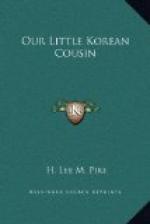When Ki Pak made one of these trips through the country he could not ride on the cars as you do, for there were no railways, with puffing engines and comfortable coaches; neither could he take a carriage drawn by swift and strong horses, for they too were unknown by the Koreans. Even if he had possessed horses and carriage, there were few roads over which they could have been driven. Most of the highways were simply rough paths, over which men usually travelled on foot or on the backs of ponies up and down the hills of the country. It was generally necessary to cross rivers by fording, though, where the water was too deep for this, rude and clumsy ferry-boats were provided. Occasionally, over a narrow stream, a frail footbridge would be built.
You can easily imagine Yung Pak’s joy and surprise one day when his father told him that he proposed to take his little son on his next journey.
Ki Pak had been ordered by the king to go to Chang-an-sa, a city among the Diamond Mountains, near the eastern coast of Korea, and about eighty miles from Seoul. In this place was a famous monastery, or temple, which would be an object of much interest and wonder to Yung Pak.
It was decided, also, that Wang Ken should be one of the party. He would be able to explain to Yung Pak many things they might see on the way.
There was much to do to get ready for the journey. It would take four days to cover the distance, and, as hotels were unknown along the route, it was necessary to take along a good supply of provisions, bedding, cooking utensils, and all sorts of things they might need while absent from home.
In addition to getting together all this material, ponies and drivers had to be engaged. Sometimes, when Ki Pak went on short journeys, he was carried in a chair by strong men, who by much practice had become able to endure the fatigue of travel, and of bearing heavy burdens. This chair was very different from the kind you have in your houses. Even a comfortable rocker would not be very nice in which to take a long journey.
The Korean traveller’s chair consists of a boxlike frame, of such height that one may sit within in Turkish fashion upon the floor. The roof is of bamboo, covered with painted and oiled paper. The sides also are covered with oiled paper or muslin. In some cases a small stained glass window is set in the side or front, but only rich men can afford this luxury. The curtain in front can be raised or lowered. This serves the double purpose of shutting out the glances of the curious and keeping out the cold air. When the owner can afford it, an ample supply of cushions and shawls makes the clumsy vehicle more comfortable for its occupant.
The chair rests upon two long poles, which hang by straps upon the shoulders of four stout men. Under ordinary circumstances these men can travel with their burden from twenty to thirty miles a day.
Sometimes, also, when Yung Pak’s father went about the streets of Seoul, he rode in a chair very similar to the one just described. The only difference was that it rested on a framework attached to a single wheel directly underneath. This cross between a wheelbarrow and a sedan-chair was supported and trundled along the street by four bearers.




